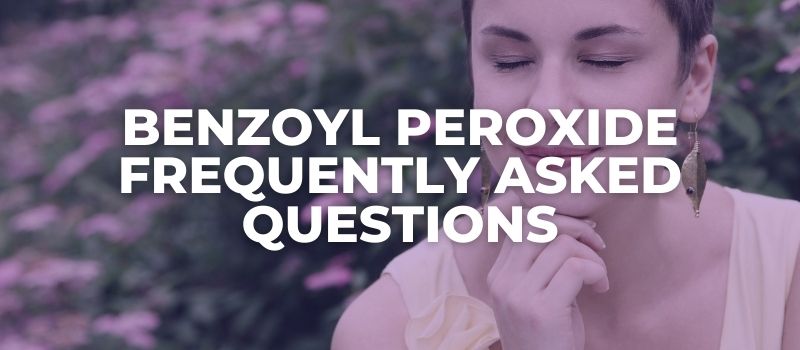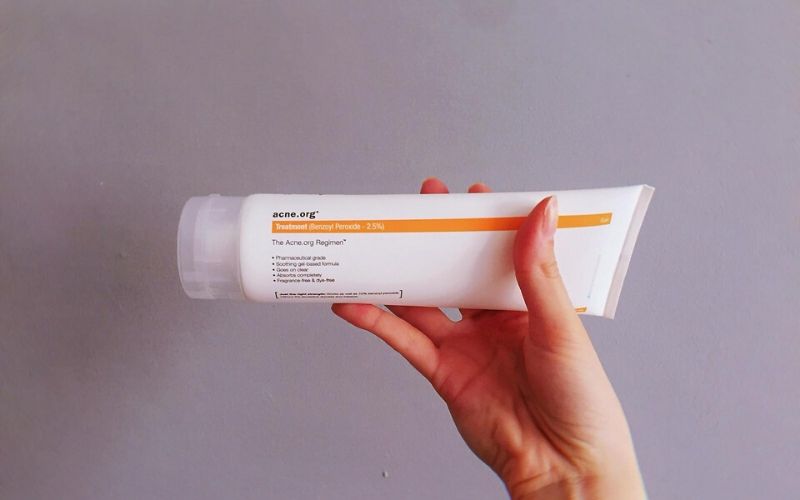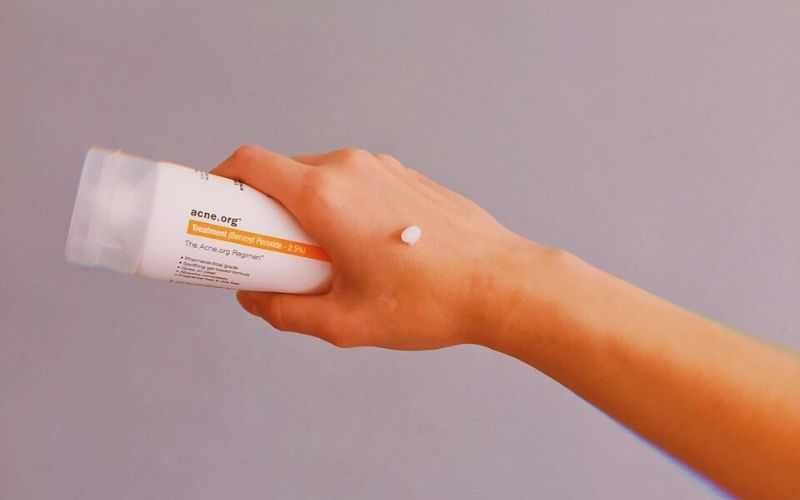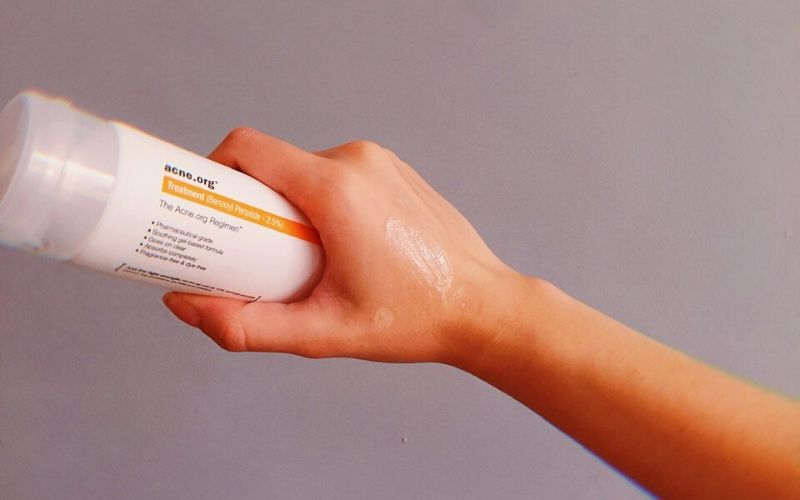Benzoyl peroxide is an ingredient that’s best known for fighting acne and it comes in various formulations, including over-the-counter cleansers, spot treatments, gels, creams, etc.
It’s also available in different concentrations but the standard over-the-counter strength is 2.5%.
However, depending on the severity of your breakouts, your dermatologist can prescribe benzoyl peroxide treatment of up to 10% in strength.
But, although efficient, benzoyl peroxide is notorious for drying out the skin, so in this article, I will teach you a few important things you need to know about how benzoyl peroxide works and how you should use it for best results and minimum downside.
In this article, you will learn:
- What is benzoyl peroxide?
- What does benzoyl peroxide do to your face?
- How does benzoyl peroxide treat acne?
- How should you use benzoyl peroxide for the best results?
- Best benzoyl peroxide products.

What is Benzoyl Peroxide?

Benzoyl peroxide is one of the most common ingredients in skincare products designed to combat acne breakouts and it is often found in cleansers, toners, gels, and creams.
It is an industrial chemical that belongs to the peroxide family of chemicals and was first made in 1905 but it didn’t come into medical use until the 1930s.
Needless to say, this ingredient has been around for a while with undergoing excessive testing and researches of its potency and efficacy.
Through many studies, benzoyl peroxide was proven to have an antibacterial effect that specifically inhibits and destroys the acne-causing bacteria Cutibacterium acnes or simply C. acnes that live deep in your pores and survive on your natural oil, dead skin cells, and skin tissue.
How Does Benzoyl Peroxide Kill Bacteria?
Cutibacterium acnes is a gram-positive bacterium that is naturally a part of your skin’s flora and primarily lives on fatty acids present in the sebum that’s secreted by the sebaceous glands.
This means that the bacteria are always present on your skin and are typically harmless unless triggered.
Sometimes, due to various reasons, your sebaceous glands that produce the natural oil to lubricate and moisturize your skin are thrown out of whack.
This can be blamed on hormonal imbalances, poor hygiene, irregular cleansing, using harsh products that are stripping your natural skin barrier, etc.
As a result of the overproduction of sebum, your skin starts “suffocating” and this creates an airless environment that causes the C. acnes bacteria to turn sebum into fatty acids that activate inflammation in nearby skin cells.
Researches from the University of California have found that the fatty acids inhibited by the C.acnes bacteria deactivate enzymes that normally act as a “brake” on inflammation.
Once the brake is off, your immune system responds to the presence of C.acnes bacteria by releasing chemicals that evoke inflammation.
This is where benzoyl peroxide steps on the scene.
Benzoyl peroxide is a powerful oxidizing agent that possesses potent antibacterial properties, therefore:
Benzoyl peroxide travels deeper into the layers of your skin to dissolve the build-up of sebum and infuse the pores with oxygen in order to destroy the airless environment where C. acnes bacteria thrive.
What Does Benzoyl Peroxide Do To Your Face?

Benzoyl peroxide is exceptionally efficient when it comes to treating inflammatory acne such as cysts and nodules. Still, it is less effective in treating blackheads and whiteheads because although they are considered as acne, these are a mild form of non-inflammatory acne.
This means that benzoyl peroxide has anti-inflammatory properties that soothe inflammatory response on the skin caused by acne breakouts.
It is a potent oxidizing agent that works to destroy the perfect airless environment where C. acnes bacteria thrive and reduce acne breakouts on your skin as early as five days after starting treatment.
It is also helpful to use in combination with prescription antibiotics depending on the severity of the concern as it has the ability to prevent antibiotic resistance.
It works to dissolve the build-up of sebum and dead skin cells and further decongests the pores to prevent future breakouts.
Does Benzoyl Peroxide Darken Skin?
No, benzoyl peroxide doesn’t darken the skin. Due to its keratolytic properties, it can help speed up cellular turnover, which in turn evens out hyperpigmented acne scars and other discolored areas of the skin.
How To Use Benzoyl Peroxide?
Benzoyl peroxide is often deemed the devil, especially in the natural skincare community that believes it is extremely harmful and can trigger serious side effects, including endocrine disruption.
However, as an esthetician and someone who is well familiar with how benzoyl peroxide works, I can confirm that incorrect use of benzoyl peroxide can cause unwanted side effects.
But this has nothing to do with benzoyl peroxide and has everything to do with the incorrect ways of using it.
Benzoyl peroxide is nowhere near being the devil of skincare ingredients.
It is a strong and effective ingredient that requires a supportive skincare routine in order to give amazing benefits without unwanted side effects.
So, how do you use benzoyl peroxide correctly? Here are some important points to remember:
Start Lower
Studies have shown that 2.5% benzoyl peroxide is equally effective as 10% and causes significantly less irritation when used in the beginning.
The concentration that you choose to use depends on your skin sensitivity.
Patch Test
Let’s start with the basics here.
Before using this product for the first time, regardless of the strength, you need to check if it can trigger a potential allergic reaction on your skin.
To do this, you should apply a small amount of benzoyl peroxide on areas such as the inner portion of the elbow or behind the ear and keep it for 12-24 hours.
Allergic reactions typically manifest within the first 15-45 minutes. If you don’t experience any irritation or burning during this time, chances are that you won’t develop an allergic reaction. However, you should always play it safe and wait at least 24 hours before applying benzoyl peroxide all over your face.
On the other hand, if an allergic reaction occurs, this product is not the best option for treating your acne concern and you shouldn’t try to go any further with it.
Read Instructions of Use
There are a variety of products available that contain benzoyl peroxide.
Many of them can be purchased without a prescription in lower strength and can come in the form of cleansers, toners, gels, and creams.
If you get a cleanser or toner containing benzoyl peroxide, make sure to read the instructions as the product may require shaking to deliver optimum results.
Don’t think this is less important. If it’s written on the product, it’s there for a reason.
Allow Your Skin to Adjust
Once the patch test is done and you are good to go as there wasn’t an allergic reaction, you may want to start introducing benzoyl peroxide slowly into your skincare routine.
Apply no more than a pea-size amount on damp skin and allow it to dry for 5-10 minutes.
It is also important that you use it every other night for the first week or so before slowly increasing your usage to every night.
Once your skin gets fully adapted to the treatment, you can even increase the usage to up to twice a day, according to your skin’s needs.
However, if you notice that your skin is becoming overly dry, tight, and even uncomfortable, this may mean that you are either using too much product or you don’t have a supportive enough skincare routine to follow up with the treatment.
Follow up With a Moisturizer and Sunscreen
When using benzoyl peroxide, the most important thing is to have a skincare routine that will support the treatment and allow it to give excellent results without unwanted side effects.
Therefore, it is important to use an adequate moisturizer after the benzoyl peroxide treatment to prevent excessive dryness and possible irritation.
Additionally, benzoyl peroxide has the ability to make your skin more sensitive to the sun, so make sure that you are using broad-spectrum, high SPF every single day of the year to avoid potential skin damage such as hyperpigmentation, skin discoloration, and protect your skin from skin cancer.
How Long Does It Take For Benzoyl Peroxide To Work?

Benzoyl peroxide is a very efficient oil-soluble agent that penetrates deep inside the pore to dissolve sebum and destroy the airless environment where the acne-causing bacteria thrive.
Once applied, benzoyl peroxide starts to work immediately and it may take as little as 5-7 days to notice an improvement on your skin.
Can You Use Benzoyl Peroxide Every Day?
It is advisable that you start introducing benzoyl peroxide slowly into your skincare routine. Start with a small application every 2-3 days and slowly build up to everyday use as this will minimize potential irritation and discomfort.
Can You Mix Benzoyl Peroxide With Other Ingredients?
Can You Mix Tretinoin With Benzoyl Peroxide?
Can You Mix Niacinamide With Benzoyl Peroxide?
Can You Mix Salicylic Acid With Benzoyl Peroxide?
The Best Benzoyl Peroxide Products for Acne
Here are some of my favorite benzoyl peroxide products you can use to combat acne and minimize inflammation on the skin:
CeraVe – Acne Foaming Cream Cleanser 4% Benzoyl Peroxide
CeraVe is one of those brands that are hyped up for several good reasons. Their products are simple, affordable, and efficient.
Their acne cleanser contains 4% benzoyl peroxide that helps dissolve sebum, unclog pores, and destroy the acne-causing bacteria.
However, this gentle cleanser also contains ceramides which are waxy lipids that strengthen the skin barrier and hyaluronic acid that helps to retain skin’s natural moisture and niacinamide which is an amazing brightening and calming agent.
It is an excellent introduction to benzoyl peroxide and it might be an ideal product for you if you have acne but your skin is also very sensitive.
Paula’s Choice – CLEAR Skin Clearing Treatment 2.5% Benzoyl Peroxide
Paula’s Choice Benzoyl Peroxide treatment is another excellent product that helps fight acne while also containing soothing and hydrating ingredients to prevent potential dryness and irritation.
The product contains 2.5% benzoyl peroxide as an active ingredient but besides that, it is also infused with bisabolol which is a soothing agent derived from chamomile as well as allantoin which is a gentle skin conditioning agent with calming properties, making this product an excellent option for beginners with benzoyl peroxide or someone with more sensitive skin.
Acne.org – 2.5% Benzoyl Peroxide Treatment (my absolute favorite)
This one is hands-down the best benzoyl peroxide treatment I have used so far.
That being said, it does require some getting used to, so if you are someone with very sensitive skin, you might be better off with some of the options mentioned above.
What I love most about this product is that it is a straight-to-the-point treatment with no bs or anything else. You apply it, you wait for a few minutes until it dries, and continue with a moisturizer or sunscreen in the morning.
Ingredients-wise, this product doesn’t contain hydrating ingredients, so if you opt for this one, make sure to have a good moisturizer to pair it up with or otherwise your skin will be one hell of a dry mess.
Possible Side Effects of Using Benzoyl Peroxide Incorrectly

Prescription-strength benzoyl peroxide can be extremely irritating if used without the adequate skincare routine to support it.
This can cause dry, red, itchy, and even peeling skin, which is in no way something you want nor need to be dealing with.
Therefore, you can try minimizing the usage of benzoyl peroxide to once a day or once every two days if this happens, and make sure to follow it up with a gentle and hydrating moisturizer.
Benzoyl peroxide is considered the king of combating acne by some but proclaimed as the toxic devil of skincare by others.
In reality, benzoyl peroxide is not something that you should be scared to experiment with just because of useless fear-mongering spread by the natural skincare community.
Benzoyl peroxide has repeatedly shown its effectiveness in destroying the acne-causing bacteria through numerous studies over the years, therefore, chances are that it will work for you, too.
All you have to remember when using benzoyl peroxide is to have a good skincare routine that will support the treatment and allow it to give the best results with no downtime or any side effects.

My name is Simone and I am a certified skin specialist. I created this website to teach my readers how to take great care of their skin and I also like to occasionally share my honest opinions on skincare products I’ve tried. You can learn more about me here.

Hi! I’m 36. I have very very oily skin on my forehead and cheeks. I usually have 1-2 pimples on my face at all times. I have congested pores that have little hard wax tiny plugs that come out with an extractor.i have sensitive skin. What would you recommend?
Hi there!
You can try using the BHA Blackhead Power Liquid by COSRX or the Skin Perfecting 2% BHA Lotion by Paula’s Choice 🙂